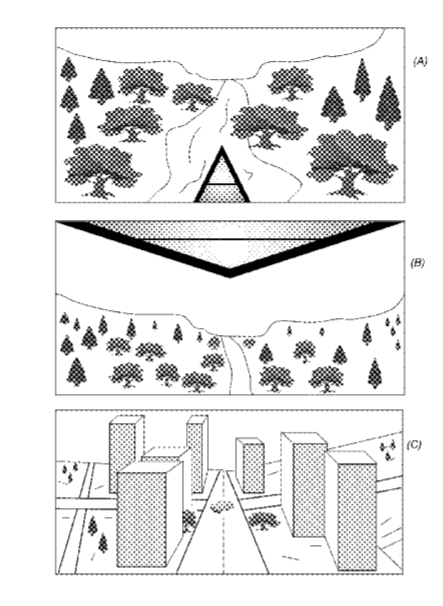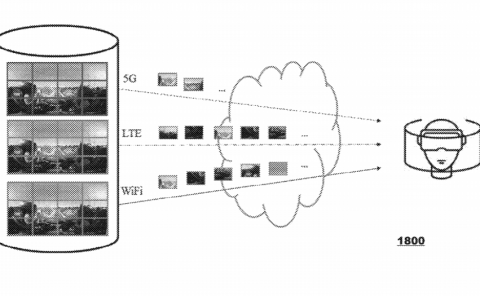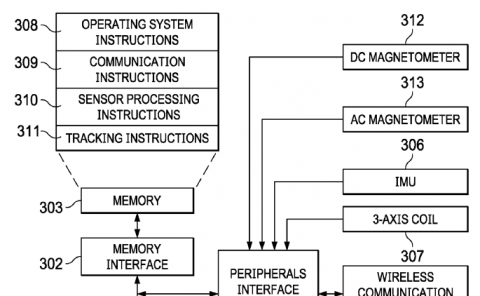Apple Patent | Immersive Virtual Display
Patent: Immersive Virtual Display
Publication Number: 10643391
Publication Date: 20200505
Applicants: Apple

Abstract
A VR system for vehicles that may implement methods that address problems with vehicles in motion that may result in motion sickness for passengers. The VR system may provide virtual views that match visual cues with the physical motions that a passenger experiences. The VR system may provide immersive VR experiences by replacing the view of the real world with virtual environments. Active vehicle systems and/or vehicle control systems may be integrated with the VR system to provide physical effects with the virtual experiences. The virtual environments may be altered to accommodate a passenger upon determining that the passenger is prone to or is exhibiting signs of motion sickness.
BACKGROUND
Virtual reality (VR) allows users to experience and/or interact with an immersive artificial environment, such that the user feels as if they were physically in that environment. For example, virtual reality systems may display stereoscopic scenes to users in order to create an illusion of depth, and a computer may adjust the scene content in real-time to provide the illusion of the user moving within the scene. When the user views images through a virtual reality system, the user may thus feel as if they are moving within the scenes from a first-person point of view. Similarly, mixed reality (MR) combines computer generated information (referred to as virtual content) with real world images or a real world view to augment, or add content to, a user’s view of the world.
SUMMARY
Various embodiments of methods and apparatus for providing enhanced virtual reality (VR) and/or mixed reality (MR) experiences for passengers in vehicles are described. Embodiments of a VR system are described that may implement VR methods, for example to address problems with vehicles in motion that may result in motion sickness for the passengers. Embodiments of the VR system may provide immersive VR experiences to passengers in vehicles, for example by replacing the view of the real world with any of various types of virtual experiences and environments that a passenger may desire. Vehicle motions may be integrated into the virtual experiences to help prevent motion sickness. In some embodiments, active vehicle systems and/or vehicle control systems within constraints, may be integrated with the VR system to provide physical effects with the virtual experience, for example rushing wind or heat through the HVAC system, surround sound and sound effects through the audio system, and acceleration or motion effects through the seat.
In addition to reducing motion sickness, embodiments of the VR system may provide enhanced immersive virtual experiences to passengers in moving vehicles that are not achievable in conventional stationary VR systems. Integrating the VR system with a vehicle in motion provides opportunities for enhancing virtual experiences that are not available while sitting in a room using a stationary simulator or wearing a HMD. For example, accelerations and motions in a virtual experience can be matched to or enhanced by accelerations and motions of the vehicle,* and thus do not have to be simulated using gravity vectors as in a stationary simulator*
In some embodiments, a VR system may include at least one VR controller that generates virtual content for projection to passengers, and at least one VR projection or display device such as a headset, helmet, goggles, or glasses (referred to herein as a head-mounted display (HMD)) that includes a projector mechanism for projecting or displaying frames including left and right images to a passenger’s eyes to thus provide 3D virtual views to the passenger. Alternatively, in some embodiments, a VR system may include at least one VR controller that generates virtual content for projection to passengers, and at least one projector mechanism for projecting or displaying virtual frames to at least one window of the vehicle to thus provide 3D virtual views to passengers. In either case, the 3D virtual views may include views of the passenger’s environment, including the environment outside the vehicle, augmented with virtual content (e.g., virtual objects, virtual tags, etc.), or alternatively may provide immersive VR environments that may include visual cues of the environment outside the vehicle.
Embodiments of the VR system may integrate inputs from a number of sources, including but not limited to vehicle internal and external sensors (e.g., depth cameras (e.g., LiDAR) and video cameras), vehicle and HMD inertial-measurement units (IMUs), vehicle control systems such as throttle control, braking, steering, navigation, and active suspension systems, world maps, 3D models, video, audio, and other information from external sources such as cloud-based storage or network-based applications, video or audio inputs from vehicle AV systems, and user devices such as notebook computers, tablets, or smartphones, to generate immersive virtual content for output through HMDs or other VR projection systems. In some embodiments, the VR system may also generate signals to the vehicle control systems (e.g., to control braking, acceleration, steering, or suspension/motion within constraints) and vehicle active systems (e.g., audio and HVAC systems, and active seats) to provide physical effects synchronized with the projected virtual content to further enhance the passenger’s experience.
Some passengers may tend to experience motion sickness more than others when using a VR system in a moving vehicle. In some embodiments, the VR system may adapt the VR environment and experience to accommodate different passengers’ preferences and tendencies. For example, visual cues that indicate flow past a passenger may be slowed down or sped up when compared to the actual speed or acceleration of the vehicle to accommodate different passengers’ preferences and tendencies. In some embodiments, the VR system may monitor a passenger for signs of discomfort or motion sickness. If signs of motion sickness are detected, the VR system may adapt the virtual environment to mitigate motion sickness, for example by slowing down the visual cues so that there is a 1:1 mapping ratio to actual vehicle speed or acceleration. In addition to adapting the mapping ratio for passengers to help prevent motion sickness, one or more other visual and audio techniques or cues (referred to as accommodations) may be used in VR experiences to increase the comfort of and mitigate motion sickness for passengers using the VR system in a vehicle.
BRIEF DESCRIPTION OF THE DRAWINGS
FIG. 1 illustrates a virtual reality (VR) system including a head mounted device (HMD) that may be used by passengers in vehicles, according to some embodiments.
FIG. 2 illustrates a VR system that projects VR content to a window of a vehicle for viewing by passengers, according to some embodiments.
FIG. 3 illustrates projecting VR content so that it appears to the viewer to be in space in front of the vehicle, according to some embodiments.
FIG. 4 illustrates projecting VR content so that it appears to the viewer to be in space in a real world view from the vehicle, according to some embodiments.
FIG. 5 illustrates projecting VR content so that it appears to the viewer to be in space in a simulated view from the vehicle, according to some embodiments.
FIG. 6 illustrates a VR system in a vehicle, according to some embodiments.
FIG. 7 is a block diagram illustrating components of a VR system in a vehicle, according to some embodiments.
FIG. 8 is a block diagram illustrating active systems in a vehicle that may be used in a VR system to provide synchronized physical effects for passengers, according to some embodiments.
FIGS. 9 through 11 illustrate several example VR experiences that may be provided by embodiments of a VR system, and are not intended to be limiting.
FIG. 12 is a high-level flowchart of a method for providing VR experiences to passengers in vehicles, according to some embodiments.
FIG. 13 is a flowchart of a method for providing virtual content in a mixed reality view of the environment to passengers in vehicles, according to some embodiments.
FIG. 14 is a flowchart of a method for providing immersive VR experiences with environmental effects to passengers in vehicles, according to some embodiments.
FIGS. 15 through 17 graphically illustrate visual accommodations that may be used in VR experiences, according to some embodiments.
FIG. 18 illustrates a VR system monitoring a passenger using a VR system in a vehicle, according to some embodiments.
FIG. 19 illustrates a VR application that adapts a VR experience to accommodate a passenger based on passenger preferences and passenger sensor data, according to some embodiments.
FIG. 20 is a flowchart of a method for adapting a VR experience to accommodate a passenger based on passenger preferences and passenger sensor data, according to some embodiments.
This specification includes references to “one embodiment” or “an embodiment.” The appearances of the phrases “in one embodiment” or “in an embodiment” do not necessarily refer to the same embodiment. Particular features, structures, or characteristics may be combined in any suitable manner consistent with this disclosure.
“Comprising.” This term is open-ended. As used in the appended claims, this term does not foreclose additional structure or steps. Consider a claim that recites: “An apparatus comprising one or more processor units … .” Such a claim does not foreclose the apparatus from including additional components (e.g., a network interface unit, graphics circuitry, etc.).
“Configured To.” Various units, circuits, or other components may be described or claimed as “configured to” perform a task or tasks. In such contexts, “configured to” is used to connote structure by indicating that the units/circuits/components include structure (e.g., circuitry) that performs those task or tasks during operation. As such, the unit/circuit/component can be said to be configured to perform the task even when the specified unit/circuit/component is not currently operational (e.g., is not on). The units/circuits/components used with the “configured to” language include hardware–for example, circuits, memory storing program instructions executable to implement the operation, etc. Reciting that a unit/circuit/component is “configured to” perform one or more tasks is expressly intended not to invoke 35 U.S.C. .sctn. 112(f), for that unit/circuit/component. Additionally, “configured to” can include generic structure (e.g., generic circuitry) that is manipulated by software and/or firmware (e.g., an FPGA or a general-purpose processor executing software) to operate in manner that is capable of performing the task(s) at issue. “Configure to” may also include adapting a manufacturing process (e.g., a semiconductor fabrication facility) to fabricate devices (e.g., integrated circuits) that are adapted to implement or perform one or more tasks.
“First,” “Second,” etc. As used herein, these terms are used as labels for nouns that they precede, and do not imply any type of ordering (e.g., spatial, temporal, logical, etc.). For example, a buffer circuit may be described herein as performing write operations for “first” and “second” values. The terms “first” and “second” do not necessarily imply that the first value must be written before the second value.
“Based On.” As used herein, this term is used to describe one or more factors that affect a determination. This term does not foreclose additional factors that may affect a determination. That is, a determination may be solely based on those factors or based, at least in part, on those factors. Consider the phrase “determine A based on B.” While in this case, B is a factor that affects the determination of A, such a phrase does not foreclose the determination of A from also being based on C. In other instances, A may be determined based solely on B.
DETAILED DESCRIPTION
Various embodiments of methods and apparatus for providing enhanced virtual reality (VR) experiences for passengers in vehicles are described. While embodiments are generally referred to herein as a VR system including VR controllers and VR projection devices that provides enhanced VR experiences for passengers in vehicles, note that some embodiments of a VR system may instead or also provide mixed reality (MR) experiences for passengers in vehicles.
The term “vehicle” as used herein generally refers to passenger vehicles. Similarly, “passenger” as used herein generally refers to occupants of a vehicle. Embodiments of the VR system as described herein may, for example, be implemented in autonomous or “self-driving” vehicles where all occupants are passengers. However, note that embodiments may also be implemented in conventional vehicles, where one occupant is the driver, within constraints. Further, embodiments may be implemented in other types of surface transportation, for example buses and trains, and may also be adapted for use in airplanes, helicopters, boats, ships, etc. The term “vehicle” as used herein encompasses all of these use cases. Also note that embodiments are generally described as providing enhanced VR experiences for passengers in moving vehicles. However, in some embodiments, the VR system may be used in stationary vehicles to provide interesting VR experiences to users. Further, in some embodiments, enhanced VR experiences in moving vehicles provided by the VR system may be recorded for later playback by the person that had the original experience or by others, for example while sitting in a living room, or while following a similar route that can be mapped to the experience. In addition, in some embodiments, two or more passengers in a vehicle, or one or more passengers in a vehicle and one or more persons at other locations such as an office or a home, may participate in a virtual environment using the VR system.



